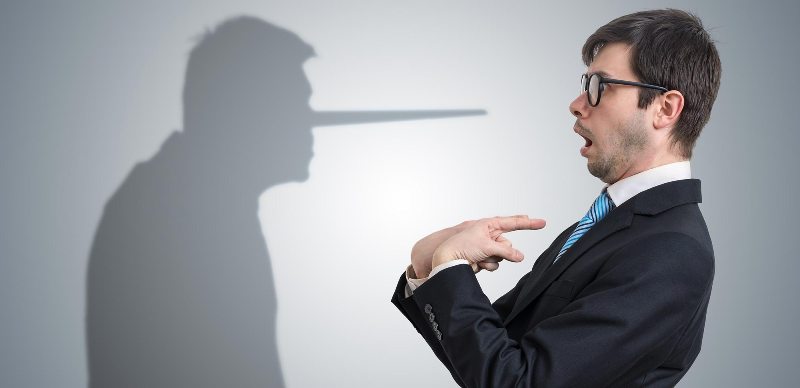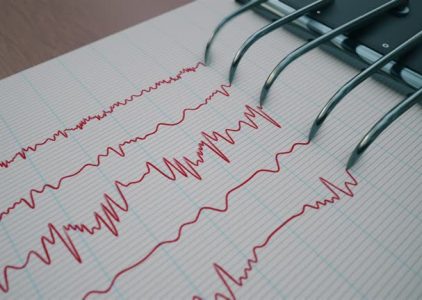
Think about the following questions.
1. Are you good at guessing when other people are lying?
2. How does the body change when someone lies?
3. Have you ever been caught lying? What happened?
VOCABULARY PREVIEW
Match each New Academic Word List(NAWL) word with the correct definition.
- minimal _____
- conduction _____
- accurately _____
- punish _____
- likelihood _____
- reliability _____
- a. correctly
- b. very small in amount
- c. probability
- d. trustworthiness; consistency
- e. to discipline; to penalize
- f. the movement of heat or electricity through something
LIE DETECTORS

Polygraphs, or instruments used to discover whether a person is lying, are commonly called lie detectors. Polygraphs are utilized in courts, in the government, and in private businesses. However, they are controversial. Many people don't believe that polygraphs can accurately identify whether an individual is lying, while others believe that polygraphs are simply tools to intimidate1 people into confessing guilt, regardless of whether they're really lying.
The older, analog polygraph machine consists of three styluses-or pens-and a roll of paper that slides across the machine. The styluses, which draw lines on the paper and record changes in the subject's condition, are connected to wires, which are in turn connected to the test subject. A mostly straight line indicates there is minimal variation in the subject's body. A jagged2 line with multiple peaks and valleys illustrates a large amount of variation. Modern digital polygraphs are interpreted in a fashion identical3 to analog polygraphs; however, instead of paper, the lines are displayed on a computer monitor.
Polygraph tests are interviews. Examiners ask subjects questions, and when subjects answer, their body reactions are recorded by the polygraph. During the interviews, examiners document the behavior of the lines on the paper subsequent to each question. Later, examiners use these results to assess the likelihood that the subject is telling the truth. When lying, individuals are often apprehensive4 about being caught, and this uneasiness produces stress. Stress triggers elevated heart and breathing rates and an increase in perspiration5, all of which are then detected by the polygraph.
To detect changes in respiration, rubber tubes filled with air are positioned around subjects' torsos, and as subjects breathe, the air in the tubes is compressed6, and the tubes expand. When the tubes expand, they push against a part of the polygraph called the bellows. The greater the expansion of the tubes, the greater the contraction of the bellows, which moves an arm on the polygraph. Breathing quickly results in an irregular line on the test. To measure heart rate, subjects wear bands around their wrists7. A tube connects the band to a second arm on the polygraph. As blood travels through the wrist, it creates very small sounds, and when subjects experience stress, the sounds become louder and faster. These sounds move the air in the tube, and the air pushes the bellows, moving the arm on the polygraph. A stronger, faster heart rate results in a more jagged line. Finally, the polygraph measures perspiration on the fingertips with metal plates called galvanometers, which are attached to two fingers. The galvanometers measure the skin's conduction of electricity. When people perspire, the skin becomes wet, and if subjects' skin is wetter than usual, it conducts more electricity. The galvanometers are connected to the third arm of the polygraph, and if the skin starts to increase in electrical conduction, movement of the arm increases. A comparison of the movements of all three arms should reveal to the examiner increases in stress for certain questions.
Many people debate the reliability of polygraphs. They believe that although these tests measure variations in the body associated with stress, these variations could be the result of other kinds of emotions. While some people experience minimal to no stress when lying, some honest people may experience intense stress from the exam itself. Because of this, it is possible for the examiner to wrongly deduce8 that the subject is lying, and the subject might then be unfairly punished. Even companies that produce polygraphs indicate that the mechanisms cannot detect lies, suggesting that polygraphs can only identify behavior that should not be trusted. Because of these criticisms, polygraph data cannot be used as evidence in American courts. Also, American law prohibits private companies from forcing employees to take polygraph tests. Despite this, both the American government and businesses continue to utilize polygraphs. In fact, workers for government agencies can be fired if they fail or refuse to take a polygraph test. Various opponents of polygraphs have concluded from this fact that the tests are used to intimidate workers, to make them confess to wrongdoing, or prevent them from complaining about company policies. Regardless, it's clear that polygraph tests will continue to affect the lives of employees.
New Academic Word List
- intimidate 1 : v. to fill with fear
- jagged 2 : adj. uneven; having sharp points
- identical 3 : adj. exactly the same
- apprehensive 4 : adj. nervous
- perspiration 5 : n. sweat
- compress6 : v. to press or squeeze
- wrist 7 : n. the part of the body where the hand joins the arm
- deduce8 : v. to conclude
READING COMPREHENSION
A ‣ Mark each statement as true (T) or false (F) according to the reading.
- Styluses are pens that make lines on paper during polygraph tests.
- True
- False
- Digital polygraph machines work very differently from analog ones.
- True
- False
- The subject's heart rate is monitored using tubes around the wrists.
- True
- False
- Wet skin conducts more electricity than dry skin.
- True
- False
- Polygraph test results are acceptable as evidence in US courts.
- True
- False
B ‣ Choose the best answer according to the reading.
- What is the reading mainly about?
- a. The difference between old and new polygraph machines
- b. The problems with polygraph test accuracy
- c. How polygraphs work and why they are controversial
- d. How polygraphs were invented and why they were banned
- Tubes around the subject's torso help to measure _____.
- a. perspiration
- b. heart rate
- c. breathing rate
- d. electricity
- We can guess from paragraph 5 that _____.
- a. some people can pass a polygraph test even if they are lying
- b. polygraph tests very rarely result in false accusations
- c. it is not normal to experience stress when lying
- d. it is becoming easier to fake polygraph results
- People can be required to take polygraph tests in American
- a. schools
- b. courts
- c. police departments
- d. government agencies
C ‣ Look for the answers in the reading and write them on the lines.
- In polygraph results, what do a straight line and a jagged line indicate?
_____ - According to some critics of polygraph tests, what is the real purpose of the tests?
_____
SUMMARY
Fill in the blanks with the phrases in the box.
- heart rate, etc.
- limited legally
- falsely identify
- reactions to stress
- detect deception
- examiners interview
| Institutions commonly use polygraphs to 1 _____, but their use remains controversial. | |||
| Polygraphs are instruments that can detect physical 2 _____ | Critics point out the test may 3 _____ the reasons for stress. | ||
| 4 _____ subjects with a series of carefully selected questions. | The polygraph machine measures changes in 5 _____. | Because of this, the use of test results has been 6 _____. | |
VOCABULARY PRACTICE
Fill in the blanks with the words in the box. Change the form if necessary.
- accurately
- conduction
- minimal
- punish
- reliability
- likelihood
- There is much debate about whether prisons should _____ criminals or try to reform them.
- Insulation is used to keep buildings warm by preventing the _____ of heat through the walls.
- You can keep your room clean with _____ effort if you pick things up regularly instead of putting it off until later.
- Mom is practical: safety, gas mileage, and _____ are the things she looks for in a car.
- Standardized tests don't always _____ predict success in higher education.
- Your parents' medical history helps determine the _____ that you will develop various diseases.
SUPPLEMENTAL READING
The Polygraph Test

A common polygraph test has several parts. The first part is an interview between the examiner and the subject, during which the two learn about each other. This is intended to reduce the subject's stress levels while allowing the examiner to see how the subject answers neutral questions.
After the interview, the examiner prepares the set of questions that he or she will ask during the polygraph test. Before the test, the examiner informs the subject what the questions will be; this reduces unnecessary stress that could make the results of the test more difficult to evaluate.
Next comes the actual test, during which the examiner asks about ten questions. Some of these questions are neutral, such as "Is your name (insert name)?" Others are control questions, which are designed to receive an untruthful answer but are not related to the offense being investigated. An example might be, "Have you ever stolen anything in your life?" The subject's response to these mildly stressful questions can then be compared to his or her response to the relevant questions.
After all the questions have been asked, the examiner checks the data from the polygraph. If the subject's stress level remained mostly the same throughout the test, the examiner may conclude the subject was honest. However, if there were moments when the subject's stress increased sharply, especially if this happened when he or she answered a specific question, then the examiner may conclude otherwise.
Fill in the blanks with information from the reading.
- The first part of the test is designed to reduce the test taker's _____ .
- The subject already knows what _____ will be before the test.
- If a subject has been honest, data should show that his or her stress levels remained _____ throughout the test.

Leave a comment
Load more